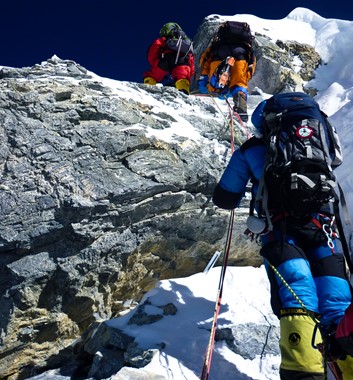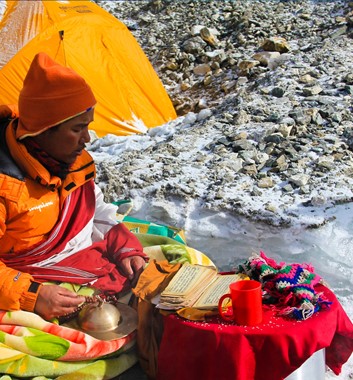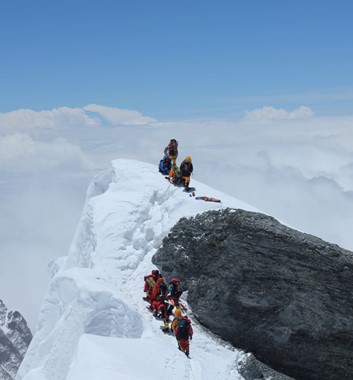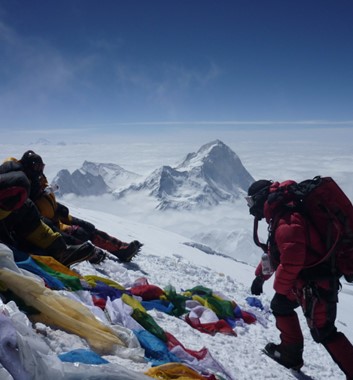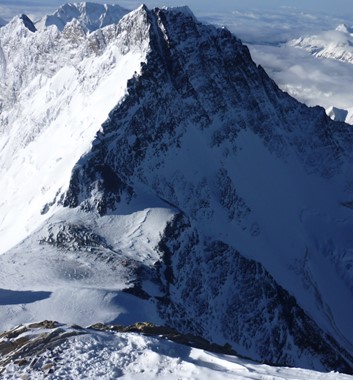Overview
Preparation for an Everest climb
We provide a complete service prior to the expedition which includes mentoring on pre-trip training and other climbs, kit advice and managing a safe acclimatisation programme over a period of time in order to build up the necessary experience and test ability and metabolic response to being at high altitude.
During preparation, we look at specific challenges facing the aspirant Everest climber, including using fixed lines, using supplementary oxygen, campcraft on ice and in exposed locations, maintaining good health at high altitude for long periods, mental preparation and teamwork.
Despite being the highest, Everest is not the most difficult of the 8000 metre peaks, but it does present certain unique challenges. Preparation and planning is a big part of the journey for any member of our team.
Mount Everest fitness
It is a requirement to be in a state of peak physical fitness for this expedition, and this normally requires a nine to six month lead-in time. An exercise regime which incorporates cardiac strength with training on all the major muscle groups, in particular the thighs and calves, and the back. Regular hill-walking with a pack on is the best exercise, building up the miles over time and carrying larger packs to a maximum of 15 kilos. The optimum schedule will be to use smaller weights with increased repetition, all the time checking recovery rates.
We recommend that you slow down the intensive physical training about a month before the expedition, it would be a shame to have an accident like a strained muscle in the few weeks before the expedition. Then, when you arrive in Nepal, the trek in to base camp will establish a good level of mountain fitness, and then the first weeks climbing up to Camp 1 and Camp 2 will provide necessary acclimatisation and continued fitness.
As important, if not more so, is the mental preparation for a trip like this. Climbing Mt Everest is a tough expedition on the mind, and also for the people you leave behind at home. Be prepared for a roller-coaster of emotions, long days of inactivity, followed by short periods of extremely strenuous activity. Boredom, loneliness and missing home are all common feelings, and it is difficult to maintain a continual feeling of positivity for so long. This is where maturity, patience and a love of just being in the mountains is so important. Every day is an experience and must be taken as just that, the successful summit is a process of cumulative good decision-making, good weather and good luck.
Technical difficulty to climb Everest
Snow and ice sections at angles occasionally over 45 degrees with steep steps and rock sections up to VD. Confident mountaineering skills including rock and ice climbing experience is important. Previous Alpine climbing or high altitude experience is required up to a minimum sustained level of Alpine AD / Scottish Grade 2/3 / Rock VD-S.
The main challenge is obviously climbing under hypoxic conditions, where even the simplest of tasks on easy ground with a small back pack becomes physically demanding and mentally taxing.
Training for altitude on a trip to Mount Everest
There is no better alternative to experience of being at altitude than to have done previous expeditions on high mountains and understand the very specific demands it makes on the body, and how your individual metabolism reacts and performs in a hypoxic atmosphere.
Your ability to work at altitude will depend on having a good idea of how you yourself can deal with it, and this takes personal knowledge of other 8000 metre peaks or at least around 7000 metres. Clearly being physically fit enables the body to more easily convert oxygen to energy, which is important in the thin air at altitude. Mental acuity is greatly affected by being at altitude, so again personal experience is vital.
It is also worth mentioning however that when climbing with supplementary oxygen - breathing at around 3 litres per minute - the net elevation of the summit of Everest (in terms of physiological impact) drops to around 7000m, which clearly makes a significant difference in terms of physical and mental resources on summit day. Oxygen provides the body with warmth, mental ability and physical strength, but this is still a very big challenge where mistakes can be costly.
Some people have reactions to foods at altitude, and some people suffer from mood swings and obviously lack of sleep which causes its own issues. All of this and more justifies the need to have adequate experience for a trip like this. We can help and advise on specific training routines, and many people do choose to go somewhere high before coming to Nepal so they are already acclimatised and mountain fit. Another option would be to train in a hyperbaric chamber before going to Nepal, and this is now becoming a popular and successful method of climbing at high altitude without having to spend weeks in a cold dry environment acclimatising.
You can read more on our additional information pages about acclimatising safely and climbing at high altitude.
Requirements for climbing Mount Everest with us
We will request a climbing CV and prefer you to have at least one 8000 metre peak on the CV as part of a varied climbing history showing a sensible development through the sport. Experience of multi day trips at 7000 metres with a high degree of self-sufficiency is acceptable. Multiple alpine seasons, Scottish winter routes for those in the UK and a build up through higher peaks, more technical routes and more committing expeditions. Everest should be a natural progression in any persons climbing history.
Being competent on crampons is an obvious necessity, plus also being able to use an ice axe efficiently. Also moving on a climbing rope, using a fixed line correctly and packing right are all essentials to being a responsible team member that everyone else can rely on.
We look for people who are used to the rigours of an expedition life at altitude. A lot of people get sick at base camp because of common ailments and knowing how to look after your health and general well being is key. Eating copious amounts of porridge at 4am in the morning is not to everyone's taste but on a trip like this keeping energy levels high is most important. Being efficient takes experience and we will look for this in the applicant, someone who can manage their personal climate effectively, move efficiently and not waste energy.
Plus of course we want a team of like-minded, open-minded generous individuals who know how to make a team work on a mountain and can contribute to the greater good of the expedition with personality and selflessness.
Do have a read of our various Blogs about treks in Nepal and also the 'More Information' section, both have tabs on this page and will answer every question you may have! We also have a lot of useful information on our Nepal Preparation page.
Dates & Bookings
Itinerary
Mount Everest itinerary
Mount Everest is a 10 week expedition in total, with 2 weeks trekking time and 8 weeks climbing period. Do not expect to go home after climbing Everest and step back into normal life though, it can take weeks and even months to recuperate fully, both physically and mentally.
We work to an agreed principle of reaching specific heights and sleeping at certain camps in a structured fashion over an eight week period having reached base camp, allowing for both stocking the camps and an optimal time for acclimatisation. The programme for climbing members is determined in large part by the schedule of stocking camps, which in turn is determined by weather and allowing for enough rest breaks. Any experienced climber will understand this policy and be comfortable fitting in with the flexibility.
Trek in and acclimatisation period on a climb of Everest
The first 10 days are spent trekking to Base Camp. There is then a period of rest and settling in. Team leaders will meet and discuss joint operations on issues like putting in the fixed lines. Teams also have to wait for the Icefall to be 'fixed' by the Sherpa teams whose job it is to put in the ladders and fixed lines. This can again take days.
The next month will be spent making a number of exploratory climbs to Camp 1 through the Khumbu Icefall, and then to Camp 2, where it is important to spend several nights. Weather and adaptation to the altitude will determine the exact days when the team climbs and rests. Carries of personal gear can be made while the Sherpas are putting in all the main equipment up to the high camps. During this time we also acclimatise by climbing another peak in the locality, such as Lobuche East or Island Peak.
There is at least one visit to Camp 3 for an overnight. It will be a good chance to test the body's response to very high altitude. For most people Camp 3 is the highest point they will reach without the use of bottled oxygen although some people opt to buy extra bottles to help getting to this point. After visiting Camp 3, there is generally a rest at Base Camp or lower, in preparation for the summit bid. We often go down to Deboche to see some grass and eat good food.
Summit period on Mount Everest
Once the decision has been made to attempt a summit in a period sometime around the middle two weeks of May (statistically this is fairly normal, but people have summited before and after), then the total summit cycle from base to summit and back is normally seven days which allows for a few nights at Camp 2 and then one night at Camp 3. The ascent to Camp 4 on the south col of Everest becomes part of the summit ascent itself, since normally teams arrive mid-afternoon and rest until about 9pm when fresh oxygen bottles are used to go up to the Balcony and join the south east ridge.
The summit morning can be beset with problems of overcrowding, in particular on the rocky step below the South Summit. Generally group order is determined by mutual agreement amongst the company guides but this is not always workable. It is not uncommon to find yourself moving very slowly behind a large group or a slow individual with no possibility to overtake. This leads to cold and excessive use of resources like oxygen. At the Balcony there is generally a change of bottles which gives an opportunity for a change in group order.
From the Balcony to the South Summit there is not much opportunity to overtake, although some groups will set up their own fixed lines to one side of the main one. It can be confusing and frustrating. Experience and a steady hand here will be very important. By sunrise we would want to be at or below the South Summit, with another two hours in hand to reach the top.
The route to the Hillary Step is narrow and exhilarating, and inevitably on a good weather day there will be a queue at the bottom of the step, and here there is no choice but to wait. The Step could be rocky or covered in snow, and it normally takes only about twenty minutes to negotiate. From there the final two hundred metres to the summit are an easy walk. The aim is to arrive mid morning leaving the whole of the rest of the day to descend back to Camp 4 and rest. Some strong teams wish to get down to Camp 3 but this is not acceptable if it leaves the Sherpas left high with a huge amount of work to do.
Coming back from Everest
A few days spent back at base camp helping to clear the camp is followed by a trek back to Lukla and a flight to Kathmandu. Some people choose to charter a helicopter, which is fine but we do feel that it is important to help the Sherpas clear the mountain and not just leave. Common courtesy and respect would suggest that everyone chips in with the break up of camp, it is far more enjoyable and should be seen as part of the trip and the experience. It takes a long time to process and assimilate an experience like this, there's really no need to rush straight to Kathmandu.
Cost
Mount Everest cost from USD$55,000.00
Please check with us first regarding availability and dates. With a large group we can manage our own base camp facilities but with a small group we share facilities at base camp and the high camps with another Nepalese company. This is normal practise on the big expedition peaks and there are several options for the guide:
1. Our own base camp facilities and our own team of Sherpas
2. Shared base camp facilities and our own Sherpa guide to work with you
3. Shared base camp facilities and shared Sherpa guide
INCLUDES
- Permit fee for Everest (currently $11,500.00 per person)
- Khumbu Icefall Fee
- SPCC garbage fee & Base Camp garbage management costs
- Fixed line collective fee above base camp
- Himalayan Rescue Assn Base Camp Fund for medical emergencies and cover for Sherpas.
- Liaison officer allowance
- Climbing Sherpa
- Base Camp staff - cook, cook assistant, porters
- Staff insurance cover for emergency evacuation by helicopter and medical insurance
- All meals
- Sleeping tents at base camp (1 per member) and shared tents at higher camps
- Toilet and shower tent
- First aid facilities and use of the HRA station at Base Camp
- Oxygen bottles (3 litre x 6 per person), plus one mask and regulator per person
- Fixed rope and snow bars (normally communally provided but we will also have our own)
- BC and C2 mess tent
- Trek costs to Base Camp and equipment transport by yaks and porters
- Accommodation in Kathmandu - twin share for 3 nights
- Lukla flight
EXCLUDES
- Western guide - can be added on a private basis.
- International travel to Kathmandu
- Any helicopter flights used for personal reasons
- Personal travel insurance
- Personal equipment and climbing gear
- Nepal visa
- Additional oxygen bottles (USD$700 each)
- Costs associated with an expedition finishing early or you leaving an expedition early.
- Costs associated with extending a trip due to bad weather or other circumstances including the cost of extra nights accommodation
- Summit day bonus to your Sherpa guide of USD$2000.00
Insurance for Mount Everest
It is a requirement of the permit for all members to have adequate insurance to cover all eventualities up to the summit of Mount Everest. It will be important to cover trip cancellation due to unforeseen circumstances, and rescue and repatriation from Base Camp which costs USD$10,000. Note that there are no official rescue operations above base camp.
Payments
A non-refundable payment of USD$1000.00 must be paid by latest November the previous year to the climb, this is to secure the services of any Sherpas who will work on the expedition.
A minimum payment of $20,000.00 must be paid by January in order to secure the early transport of gear to base camp and get a good spot on the glacier and also to pay the Government for both your permit and the administrative paperwork associated with liaison officers and garbage management.
The final payment must be made latest one month before travel.
LOCAL PROVIDERS
Adventure Alternative Nepal is the company we have set up and invested in over the years, and there is a full complement of staff and equipment available for all major expeditions.
Kit List
Mount Everest personal kit list
A full detailed kit list will be issued to expedition members with suggestions on current manufacturers and models where required.
Feet
High altitude double boots for above Camp 2
Alpine boots for up to Camp 2
Base Camp boots
Casual Shoes
Crampons 12 point
Socks - thick woollen ones and hiking
Head
Neoprene facemask
Balaclava or buffs
White sunhat with neck cover
Goggles with 100% UV lens
Sunglasses with 100% UV lens
Woolly hats
Climbing helmet
Hands
Windstopper gloves and fleece gloves
Mitts
Down mitts - heavyweight and lightweight
Liner gloves
Skin
SPF40 Sunscreen
Dermatone high altitude suncream
SPF25 lipcream
Moisturising cream
Lipsalve
Base Layer
Thermals tops and bottoms, thin and thick
Mid layer
Fleece bottoms
Fleece tops
Gilet or light down jacket
Hiking clothes
Outer layer
Windsuit
Down jacket - heavy duty
Down trousers (or complete downsuit)
Windproof trousers and jacket, or salopettes
Climbing
Ice Axe
Harness
'Cows tail' with jumar and safety karabiner
Descender (figure of 8 easiest)
Selection screwgate karabiners
Selection long and short slings
Spares
Bags
90 litre rucksack
45 litre daysack
Large duffle bag
Many stuff sacks and dry bags
Camping
5 season down sleeping bag (above BC)
4 season down/synthetic sleeping bag (BC)
1 litre metal flasks
Nalgene water bottles with insulating cover
Rucksack cover
Headtorch with batteries, high quality (and spare headtorch)
Walking poles
Thermarest
Closed cell sleeping mat
Thermos food flask
Thermal mug
Titanium spork
Towel
Box of repair kits
Leatherman
Pee bottle
Alarm clock
Personal first aid kit - details provided
Wash kit
Photos
Extras

Yak and Yeti Hotel
3 nights twin/double standard room in this luxury 5 star hotel offering a blend of modern day sophistication and cultural heritage with its 100-year-old palace and the newly designed structure of the hotel.

Kathmandu Guest House
3 nights B&B in a standard twin or double in the famous 4 star Kathmandu Guest House in Thamel, central Kathmandu. KTMGH is set in beautiful grounds with a number of restaurants and gardens, shops and museum pieces.

Kathmandu Eco Hotel
Budget hotel near city centre, price is for 3 nights double or twin room.
Choose a scheduled date or contact us to set up private dates or a bespoke itinerary. The minimum deposit is £100.00 and the balance is due four weeks before travel.
- Duration 10 weeks
- Numbers minimum 2
- Altitude 8848m
- Challenge Stenuous
- Comfort Tents
- Experience level High
- Nepal Trek emergencies
- Nepal trip preparation
- Health and altitude
- Tipping advice
- Mountaineering Preparation
- Seven Summits
- Travel Insurance
- Mountain boots and crampons
- High altitude climbing
- Acclimatising safely
- Kathmandu Accommodation
- Nepal: Local price guide
- Sleeping bag advice
- Himalayan Flight Delays




